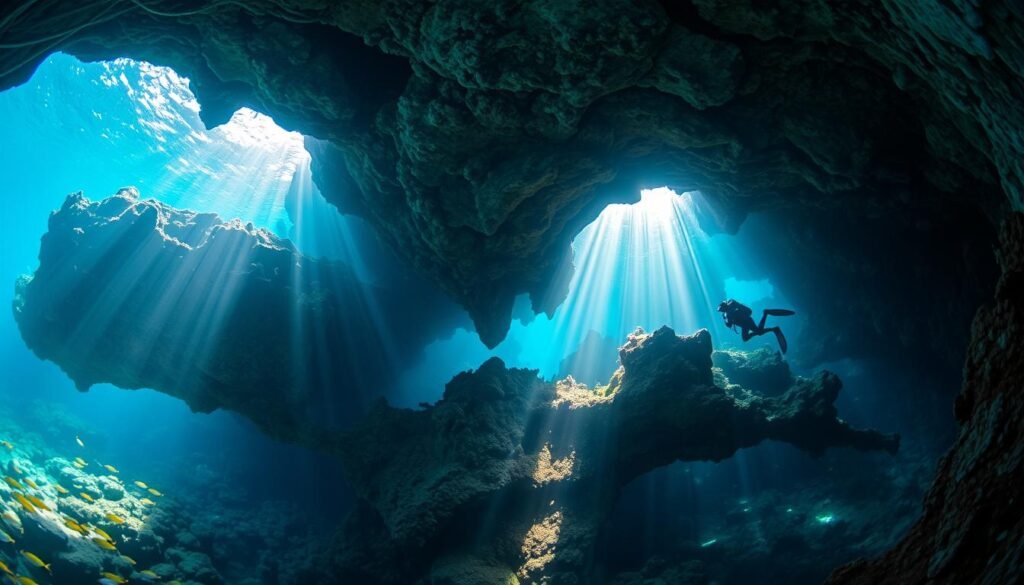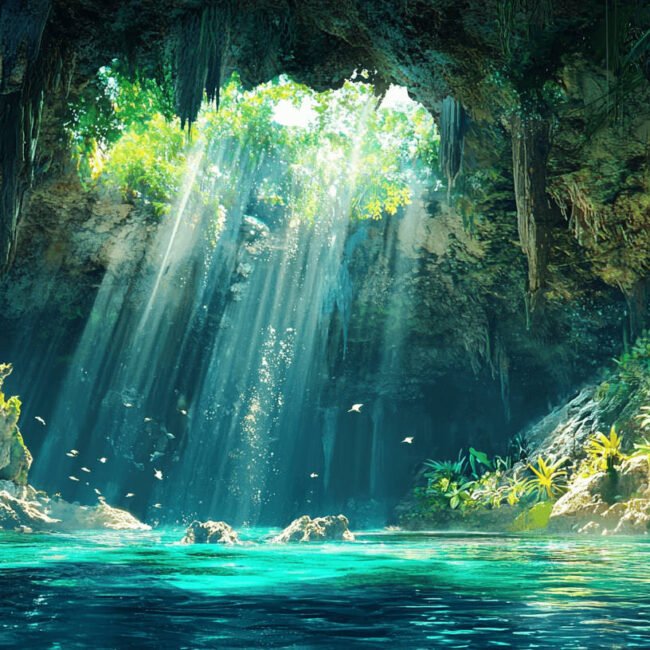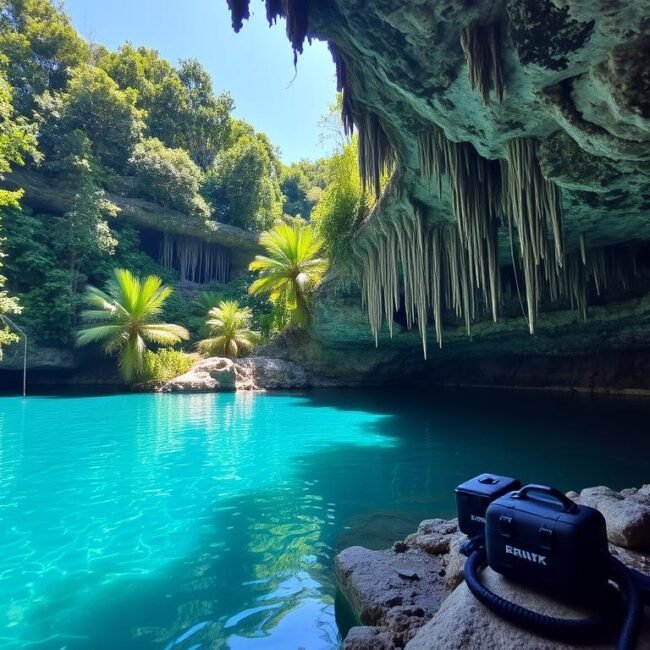“Did you know that cenote cave diving in Mexico has grown by over 30% in the past decade?” I thought, “Heck yeah, makes total sense!” After all, once you plunge into these magical underwater caverns, it’s hard not to be hooked.
I remember my first dive in a Mexican cenote: I was so hyped I nearly put my wetsuit on backwards! That morning, I got to the site with a mix of nerves and excitement. As soon as I slipped beneath the surface, I knew I’d found something special. The best time for cave diving in Mexico depends on what you want—clearer water, fewer crowds, warmer temps, or maybe a cultural festival thrown in the mix. This guide breaks it down month-by-month so you can pick your sweet spot and dive in, literally!
Understanding Mexico’s Cave Diving Seasons
When I first started figuring out the best time for cave diving in Mexico, I had no clue that the seasons could affect my experience so darn much. I knew about rain and dry spells, but I never imagined just how different the cenotes could feel from one month to the next. After a few trips—and more than a few mistakes—I realized that being in tune with the seasons can make or break your dive.
Distinct Dry and Rainy Seasons & Visibility
Mexico’s cave diving scene revolves around two main seasons: the dry season and the rainy season. During the dry season, which often runs from late fall through early spring, you’ll find stable weather, minimal rainfall, and often killer visibility inside the cenotes. The water can be so clear that you feel like you’re floating in mid-air. Once, in mid-February, I descended into a cenote and could see the bottom like it was right under my nose even though it was dozens of feet away. My jaw literally dropped, and I actually let out a muffled whoop through my regulator.
The rainy season, on the other hand, can challenge you. From about late spring through early autumn, Mexico gets hit with periodic rains that can affect visibility, cause runoff, and even close some cave entrances. I once planned a dive in July, expecting a calm day, only to find brownish water and limited entry points. I was bummed. But I learned something: adjusting your expectations and working with local operators who know their stuff can still yield a great dive. They might steer you toward a cenote less impacted by rain, keeping your adventure alive.
Seasonal Weather & Cave Accessibility
The weather patterns influence both safety and accessibility. Strong rains can raise water levels or create slippery walkways leading to the caves. One time, I slipped on a muddy trail and ended up on my backside, cursing quietly into the jungle air. Thankfully, I’d worn sturdy sandals, so my only injury was a bruised ego. For safety’s sake, it’s worth paying attention to forecasted conditions. If a hurricane’s brewing (especially between June and November), you might want to reschedule. Safety first, always.
Highest Water Clarity & Fewer Crowds
If you crave top-notch visibility and fewer divers kicking around silt, aim for the dry season months. January through March often bring crystal-clear water and quieter cenotes. It’s almost spiritual, descending in near silence, with the cavern’s contours sharp and defined. You’ll feel like an explorer stepping into a secret world few others ever see.
Cultural Events & Local Festivals
Mexico is not just about its natural beauty. It’s also rich in culture. Visiting during Día de los Muertos in late October to early November adds a special touch to your trip. Imagine diving in the morning and then exploring a village at night, filled with colorful altars and sugar skulls.
This mix of diving and cultural immersion makes your trip unforgettable. I once met a local diver who took me to a festival after our dive. We enjoyed tamales and music, and I realized that visiting during cultural events enriches your experience.
Understanding Mexico’s cave diving seasons is more than just knowing the weather. It’s about finding calm waters, fewer crowds, and maybe a cultural event to enhance your adventure. With some planning and insider tips, you can find the perfect time for cave diving in Mexico.
January – March: Cool, Crisp Waters and Quiet Cenotes
January through March offers calm mornings, crisp water, and a peaceful vibe. The dry season means clear visibility and fewer divers. I once arrived early at Dos Ojos cenote in February and had it almost to myself.
Ideal Conditions & Fewer Crowds
Tourism is usually lower during these months, except for holiday rushes in early January. This means you can dive without the crowds. I once dove into Gran Cenote in late January and felt like I was in a private underwater temple.
Water Temperatures & Visibility
Water temperatures are cooler, around 21-23°C. A good wetsuit keeps you comfortable. The cool water is refreshing and often means stable conditions for clear visibility. I’ve taken amazing underwater photos during these months, capturing stunning limestone formations.
Exploring Famous Cenotes
January through March is great for visiting famous cenotes like Dos Ojos, Gran Cenote, or The Pit. The Pit is deeper and more advanced, perfect for experienced divers. I dove The Pit in early March and felt like I was floating in a dream.
Recommended Gear for Cooler Temps
To stay warm, wear the right gear. A 5mm wetsuit is a good start, and add a hood or gloves if you get cold easily. I once forgot how cold the water would be in January and got too cold. Now, I always wear thermal protection to enjoy the dive fully.
Early in the year, booking dives is easy since it’s not peak season. Local guides are relaxed, have time to chat, and show you hidden spots. In February, a dive master took me to a hidden cavern with a tiny freshwater shrimp colony. It was unforgettable.
January through March is great for diving if you like peace and clear water. The cooler water is worth it for the serene experience. Whether you’re taking photos or enjoying the beauty of stalactites, this is the best time for cave diving in Mexico.
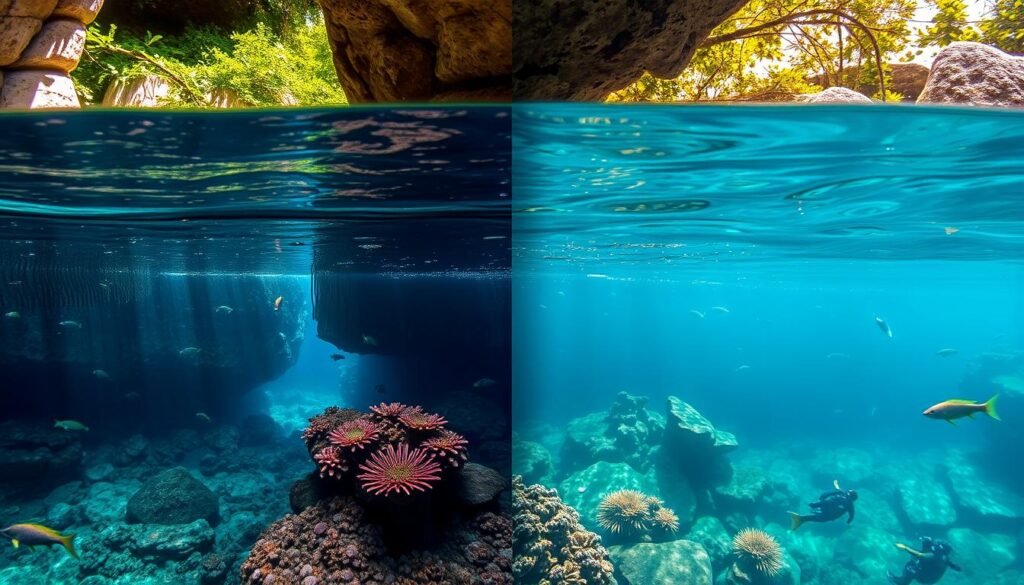
April – June: Transitioning Into Warmer Waters
Spring brings warmer waters and more life to Mexico’s cenotes. In late April, I saw tiny fish like they’d just woken up. It was like a party underwater.
Spring Weather & Cave Diving Conditions
April and May have solid visibility due to the dry season. June might see some rain, but it’s usually manageable. I’ve seen occasional showers in June, but the cenotes stay clear.
Warming Cenotes & Active Marine Life
By mid-spring, the water warms up, making dives more comfortable. In May, the water felt like a mild bath. As temperatures rise, marine life becomes more active. You might see small fish, eels, and turtles.
Balancing More Divers During Holidays
April can be busy with spring breaks or Easter getaways. Plan your dives early in the morning or midweek to avoid crowds. I learned to dive at sunrise to avoid the chaos.
Hidden Cenotes & Finding Solitude
For a quieter dive, try smaller, lesser-known cenotes. Ask a local dive shop for recommendations. In May, I found a hidden cenote with amazing formations and clear water.
Spring is also a good time for gear rental and learning from guides. The weather is pleasant, and guides are relaxed. I improved my buoyancy skills with a patient dive master.
April to June is a great time for diving if you like warmer water but still want clear visibility. You might see more divers during holidays, but with some planning, you can find the best times for cave diving in Mexico. These warmer spring months are perfect.
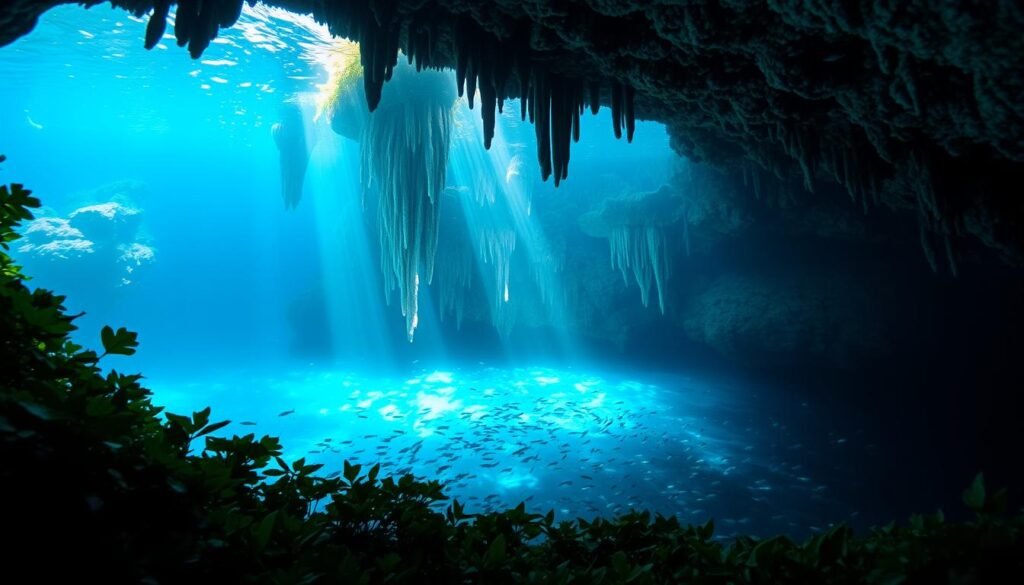
July – September: Rainy Season Challenges and Rewards
Let’s talk about July to September, the rainy season. You might think it’s a bummer, but it’s not all bad. With the right planning, you can still have amazing dives.
Rainfall & Water Clarity
Rain can make visibility poor. I once jumped into a cenote expecting okay clarity but got murky soup instead. But, some cenotes stay clearer than others.
Local dive operators know which spots are best. They can take you to hidden gems with good visibility. I once found a quiet cenote in the jungle with great clarity.
Pros & Cons of Hurricane Season
Hurricane season overlaps with these months. Storms can cancel dives, so safety is key. But, fewer tourists mean quieter spots.
I’ve had entire cenotes to myself in September. The quiet made the dive feel more real. Just watch the weather and be ready to change plans.
Adjusting Your Itinerary & Staying Safe
Rainy season means being flexible. Plans can change, but you can still find great dives. I once found a stunning cenote I never would’ve seen otherwise.
Wear good shoes because trails can be slippery. Don’t rush on paths to cenotes. I slipped once and got a muddy backside. Better than getting hurt.
Consider a warmer wetsuit layer for cooler air. Rain can make the air feel cooler, even in the tropics.
Making the Most of Summer Dives
Be patient and open-minded for a great time. Marine life is active, and the jungle backdrop is amazing. It’s an adventure.
Once, after dodging rain, I had a surreal dive. The cenote was like liquid emerald. It was worth the wait.
July to September has its ups and downs. But, with the right attitude and local advice, you can find great dives. It rewards patience and can lead to amazing stories.
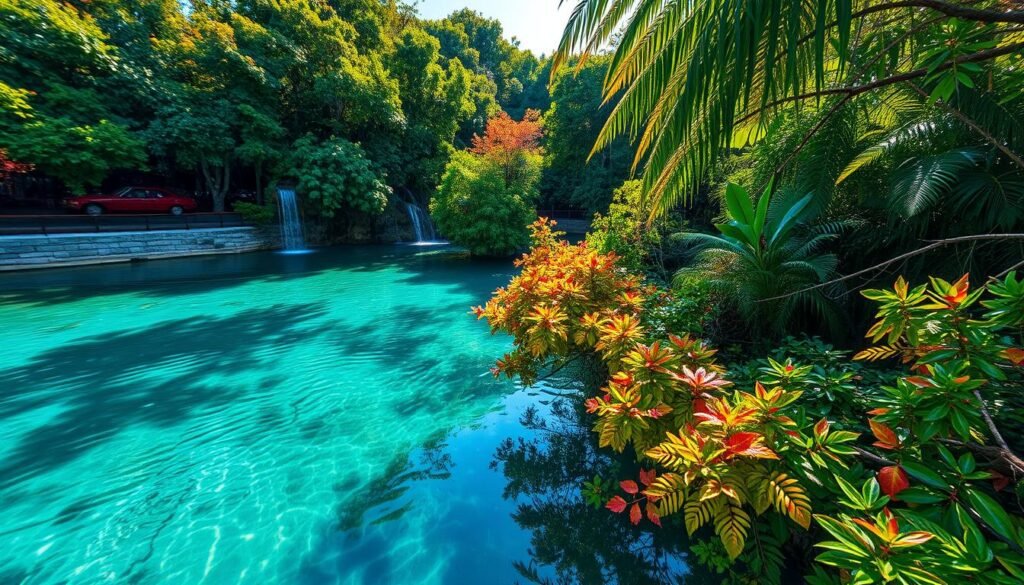
October – December: Festivities, Clear Skies, and Unique Marine Life
As the year winds down, October through December often brings a kind of balance back to Mexico’s cave diving conditions. After the crazy rainy season, the water tends to clear up again. I remember diving in November once and thinking, “Now this is the best time for cave diving in Mexico!” because everything just felt right—clear skies, good visibility, and some unique cultural twists.
Autumn & Early Winter Conditions
By October, the storms usually calm down, leaving behind refreshed ecosystems. Visibility improves, and water temperatures settle into a comfortable range, often around the mid-70s again. It feels like nature hit the reset button. I’ve dropped into cenotes in late October and found them nearly as clear as those pristine winter months. Plus, the jungle surroundings look super lush, making the whole approach to the cenote feel like you’re wandering through a hidden paradise.
Cultural Events & Diving Experience
One major bonus of diving during this period is the cultural richness. Día de los Muertos (Day of the Dead) happens in early November, and it’s a big deal in Mexico. Imagine starting your morning exploring an underwater world of stalactites, then spending the evening wandering through candlelit altars and beautifully decorated cemeteries. I did exactly that one year, and it was surreal. I learned that timing your dive trip to coincide with local festivals can give your adventure a deeper meaning. It’s not just about the diving—it’s about understanding the place, its traditions, and its soul.
Unique Marine Life & Late-Year Sightings
Some cenotes connect to underground river systems that may host different marine life during these months. I once spotted a school of small fish in December that I hadn’t seen earlier in the year. Maybe it’s because the cooler water and stable conditions bring them out of hiding. It’s a subtle difference, but if you’ve dived multiple times throughout the year, you’ll notice these shifts in underwater inhabitants. The variety keeps things fresh and exciting.
Balancing Holiday Crowds & Off-Peak Times
Now, the downside: the holiday season can draw more tourists. The week between Christmas and New Year’s can get a little busy. If that’s not your scene, consider traveling earlier in December or mid-October. I did a trip in early December once, and the cenotes were quiet again, as if everyone was waiting until the actual holiday week to show up. I got some prime dives done before the crowd rolled in. The key is to be flexible. If you must dive during a busy holiday, hit the water early. Sunrise dives have saved me countless times from noisy groups.
Overall, October through December offer a sweet combination of improved conditions, cultural immersion, and interesting marine life. If you want to wrap up your year with a memorable diving experience, this might be the perfect window. Just be mindful of the holiday rush, and consider pairing your dives with cultural explorations to make the most of your trip. I’ve found that the late-year vibe—clear skies, festivals, and a sense of closure—is a perfect way to end a year of diving adventures.
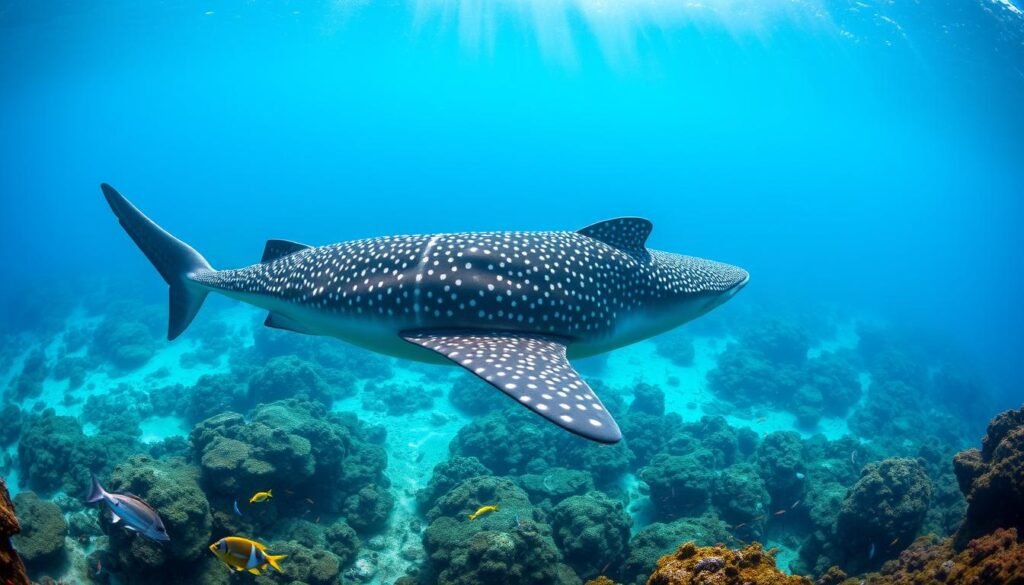
Essential Tips for a Successful Mexico Cave Diving Adventure
No matter which month you pick, having a killer cave diving adventure in Mexico comes down to more than just timing. Over the years, I’ve picked up some hard-earned wisdom—like that time I went with a cheap guide and almost ended up lost in a dark cavern. Let me save you some trouble by sharing what I’ve learned.
Finding a Reputable Local Dive Operator
Start by doing your research. Don’t just pick the first operator you find online. Look for reviews and ask other divers for recommendations. A good operator will know the best time for diving based on your interests.
They can suggest the best cenote for the day, even if it’s not the one you planned. I learned the hard way to choose an operator with proper certifications and good equipment. Now, I look for those who are friendly and maintain their gear well.
Recommended Certifications & Equipment
Cave diving is serious business. Get a cavern diving certification before diving in overhead environments. It boosts your confidence and safety.
Invest in a reliable dive light. A cheap light can fail you in the dark. Also, wear a well-fitted wetsuit, especially in cooler months. A thicker suit or hood and gloves can help if you get cold easily.
Safety Precautions & Etiquette
Respect the cenotes and their wildlife. Your actions can harm these delicate ecosystems. Move slowly and don’t touch anything unless told to.
Give wildlife space. I once saw someone chase a fish for a photo. It stressed the fish and looked silly. Always be respectful.
Maximizing Your Experience Through Photography & Journaling
Bring a camera, but first, master your buoyancy. Crash into a stalagmite and you’ll ruin your dive. Write down your dive experiences in a journal.
Notes help you remember details and plan better dives. They become your guide for future trips.
Be Flexible & Embrace the Unknown
Be open to changing plans. Weather, festivals, or new recommendations can lead to amazing dives. One of my best dives was a surprise suggestion from a local.
Life is full of surprises. Stay open-minded and you’ll have an incredible time cave diving in Mexico.
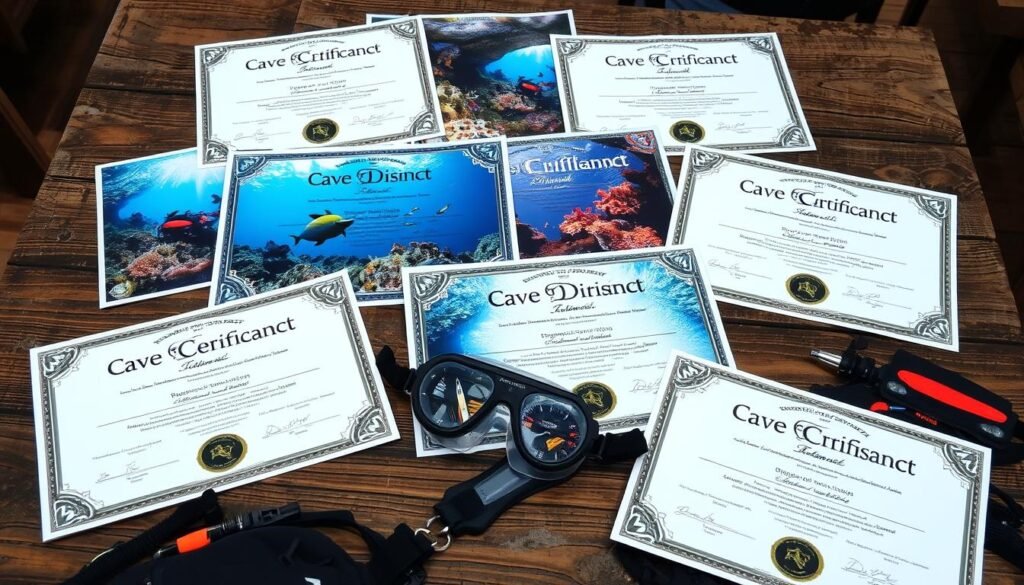
Conclusion
We’ve explored every season for cave diving in Mexico. Each has its own charm. The best time depends on what you value most.
Stay safe by getting proper certifications and choosing a reliable operator. Respect the cenotes and adapt to changing conditions. That’s the spirit of adventure!
Now, I’d love to hear from you. Have you dived in Mexico’s cenotes before, or are you just starting to plan? Drop a comment, share your experiences or your favorite month to dive. Help other underwater adventurers find their own sweet spot.
So grab your fins, your camera, and your sense of wonder. And go discover your personal best time for cave diving in Mexico!
FAQ
What is the best time for cave diving in Mexico if I want the clearest water and fewer crowds?
January through March is the best time. You’ll find clear water and fewer divers. It’s perfect for a peaceful dive.
How do the seasons in Mexico affect cave diving conditions?
The dry season, from late fall to early spring, has stable weather and clear water. The rainy season, from late spring to early autumn, can make water murky. But, it also means fewer people.
Can I still enjoy cave diving in Mexico during the rainy or hurricane season?
Yes, you can. But, be ready for changing conditions and less clear water. A local dive guide can help you find the best spots.
Are there cultural events that can enhance my cave diving trip?
Yes. Día de los Muertos in late October to early November is a great time. You can dive in the morning and enjoy local festivals at night.
What gear and training do I need for cave diving in Mexico?
You need proper training and the right gear. This includes a good dive light and thermal protection. A local dive operator can help with all the details.

